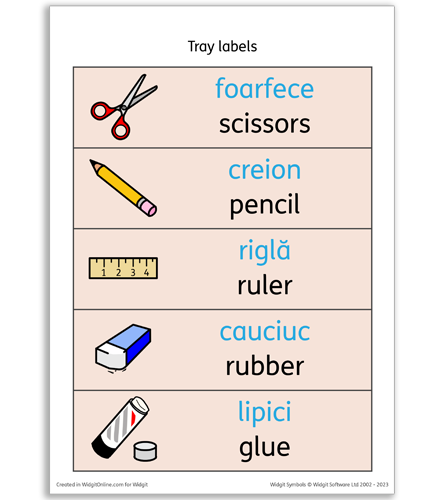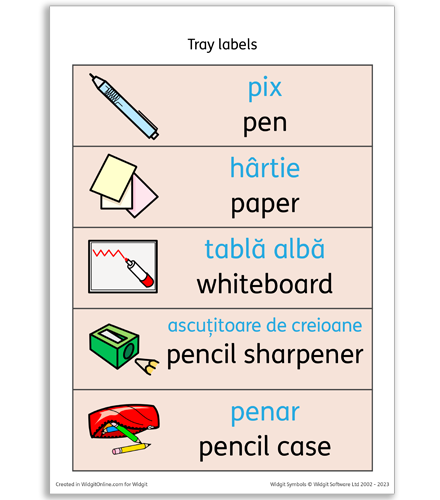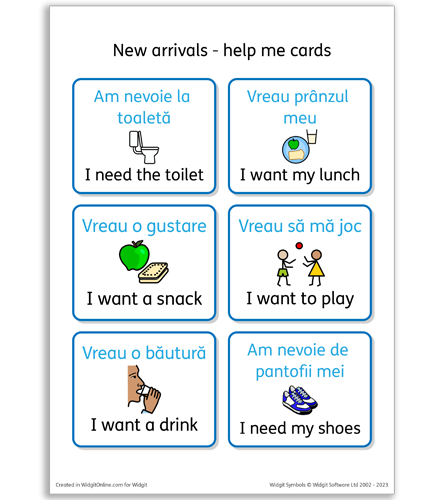- You are here:
- Home
- About Symbols
- Using symbols to support the building blocks of English Language
Using symbols to support children struggling to grasp the building blocks of English Language
Sue White, Senior Education Specialist at Widgit has been talking to Teachers from three Mainstream Primary Schools and asking them to share their tips and ideas on supporting children struggling to learn early language skills.
English is not always an easy language to grasp. Many words can sound the same but have different meanings and different spellings, like fair or fare. Or they can be spelt the same, but mean another thing altogether, like minute as in time, or minute as in small.
It can be incredibly daunting for pupils whose first language is not English to arrive in the UK and start a new school without knowing which words apply in what circumstances.
Providing the right support from the outset is essential so children feel included and have the confidence to become independent, valued members of the school.
Sue spoke with teachers from three mainstream Primary Schools and all three talked about how using symbols can help overcome barriers and explain vocabulary and topics in a more visual, enjoyable, and relatable way as well as creating an environment that everyone can access.
The schools all use Widgit Online with Dual Language feature to create resources for their EAL pupils.
Jenny Byford concludes, “I think Widgit Online is important to me in my role as School Inclusion Lead as it’s a real visual. I can walk around the school and see the adaptions of the curriculum quite easily. And it's a great bit of evidence to show that we are supporting children with EAL in different ways and adapting the curriculum to meet their needs.”
Enabling Environment


Year 6 teacher, Maria Sadler, spoke about the successful techniques used at St Andrew’s Church School in Somerset, to help children with EAL. The bedrock of their approach, is to create an environment where it’s the norm, rather than the exception, for everyone to see and learn about different languages. The school corridors and classrooms are emblazoned with dual language displays of topics, trips, and projects.
“There are three different languages spoken in my class and so I’ve created dual language displays in English and the home languages to reinforce learning and maintain a welcoming environment. As a class we’re also learning French, so I created a fourth dual display to help the children learn new vocabulary.
I also label everything in my classroom. All my cupboards and doors have visual cues using symbols to support pupils to understand what to do. I use symbols to support the text and illustrate phrases like ‘collect calculators here,’ or ‘pull the door closed.’ I’ve found using symbol signage has empowered my pupils to feel more confident about what’s being asked of them.”
“The more children see the symbolised language the more they will absorb it. And that’s what we want them to do because learning a new language is hard and we want them to be immersed in it, they need to see it, say it, hear it.”
“The more they are immersed in the language the quicker they learn. But for newly arrived children with limited understanding, deciphering written and verbal instructions can be challenging and frustrating. This then impacts on how they can engage with tasks. We are not always able to rely on extra teaching support in class and so our EAL pupils need to become independent learners as fast as possible.
Using Widgit symbols has helped pupils to become more confident learners. We incorporate them into written instructions, signage and displays throughout the whole school, menu cards and visual timetables.
When the pupils see an image, they can understand and relate it to the text. This helps children navigate their way around the school, as well as the school day and focuses on the key words and information they need to know.”
Supporting Communication

For refugee children, the frustration of not understanding what is going on in class only adds to the stress they have already faced leaving the homes they know and love suddenly because of war or conflict.
The simple icons and images used in symbols to represent vocabulary remove the frustration many EAL children feel in their first weeks and months in an unfamiliar English language school.
Timetables can include symbols which give EAL and refugee children a visual representation of what’s going on throughout the school day, such as when break time, story time and home time are happening.
Symbols help children communicate in other ways too – enabling them to express sadness or fear and even that they need the toilet by pointing to the relevant display in a classroom from day one.
Supporting Vocabulary Development

Inclusion Lead Jenny Byford, from Sauncey Wood Primary School in Hertfordshire explains “We’ve found using the simple icons and images used in symbols to represent vocabulary has helped us engage all our pupils in learning and participate more in class, whatever their learning or language ability.”
“We use them a lot in pre teaching vocabulary, not just for our EAL pupils or those who have trouble processing information, but for mainstream pupils too. For example, in language heavy subjects such as History or Science, I can use a symbol of houses to explain the word settlement, or symbols of bones when learning about the skeleton. EAL learners can also contribute during lessons by sharing relevant symbols, increasing their confidence and engagement.”
“A phrase like ‘woolly mammoths roamed’ is a lot easier to explain, and be understood, if it’s accompanied by related imagery,” says Maria Sadler. “It means that even if a child can’t read or they have limited language development, they can still contribute by pointing to the symbols and they feel valued and engaged.”
Agnieszka Kwiatowska, EAL Teaching Partner from St Gregory the Great in Gloucestershire, also uses symbols to support the understanding of stories and texts to EAL learners. She explains how interacting with symbols in the story of the Bad-Tempered Ladybird helped one of her pupils. “I used different symbols to help her understand what ‘too small’ and ‘bad tempered’ meant, she could enjoy the story more and became more engaged in the learning.”
Try Widgit Online free for 30 days
Create visual, communication and learning supports in your web browser using over 20,000 Widgit Symbols, access to over 2 million child-friendly, high quality stock images and 100s of easy-to-use templates.
Use the Dual Language templates to translate into more than 80 languages.

